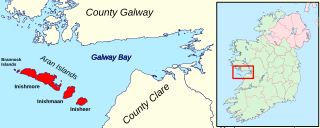
The Aran Islands or The Arans are a group of three islands at the mouth of Galway Bay, off the west coast of Ireland, with a total area around 46 km2 (18 sq mi). They constitute the historic barony of Aran in County Galway.
This is a bibliography of works relating to the Aran Islands.
Saint Enda of Aran is an Irish saint. His feast day is 21 March.

Inisheer is the smallest and most easterly of the three Aran Islands in Galway Bay, Ireland. With 343 residents as of the 2022 census, it is second-most populous of the Arans. Caomhán of Inis Oírr is the island's patron saint. There are five small settlements: Baile Thiar, Chapeltown, Castle Village, Baile an Fhormna and Baile an Lorgain.

Saint Gobnait, also known as Gobnat or Mo Gobnat or Abigail or Deborah, is the name of an early medieval female Irish saint whose church was Móin Mór, later Bairnech, in the village of Ballyvourney, County Cork in Ireland. She is associated with the Múscraige and her church and convent lay on the borders between the Múscraige Mittine and Eóganacht Locha Léin. Her feast day is February 11.

Inishmore Aerodrome is located 1 nautical mile southeast of Kilronan, a town on the island of Inishmore, one of the Aran Islands off the coast of County Galway in Ireland. It has one paved runway designated 14/32 which measures 490 by 18 m.

Inisheer Aerodrome is located on the island of Inisheer, one of the Aran Islands in Galway Bay off the coast of County Galway, Ireland. This aerodrome is licensed by the Aeronautical Services Department of the Irish Aviation Authority.

Inishmaan Aerodrome is located on the island of Inishmaan, one of the Aran Islands in Galway Bay off the coast of County Galway, Ireland. This aerodrome is licensed by the Aeronautical Services Department of the Irish Aviation Authority.
Dara Ó Conaola is an Irish writer who writes in Irish. His first book of short stories, Mo Chathair Ghríobháin, was published in 1981. A later short book of eight short stories, translated to English by Gabriel Rosenstock, was published as Night Ructions in 1990. The book was launched at the 1990 Sunday Times Festival of Literature, Hay-on-Wye, Wales.

Aer Arann Islands is an Irish airline headquartered in Inverin, County Galway. They operate a three-strong fleet of Britten-Norman BN-2 Islander aircraft to connect the Aran Islands with mainland County Galway.

Connemara Airport or Connemara Regional Airport is located at Inverin in the Connemara region of Ireland, 15 nautical miles west of the city of Galway. It is also known as Spiddal Airport, Inverin Airport, or Minna Airport, a name also used by Minna Airport in Minna, Nigeria.

Saint Caomhán, anglicised as Cavan, sometimes Kevin, is the patron saint of Inisheer, the smallest of the Aran Islands. Although he is "by far the most celebrated of all the saints of the Aran Islands", little is known about him. He is said to have been a disciple of Saint Enda of Aran, which would place him in the 6th century, but his death date has also been recorded as 865.

Cnoc Raithní is a tumulus and national monument located on Inisheer, Ireland.

Creggankeel Fort is a stone fort and National Monument located on the island of Inisheer, Ireland. It also contains a later Christian site, the Grave of the Seven Daughters.

O'Brien's Castle, also called Furmina Castle, is an early 15th century tower house and National Monument located on Inisheer, Ireland.

Templesaghtmacree is an Early Christian church and National Monument located on Inishmaan, Ireland.

Dún Conor is a stone ringfort (cashel) and national monument located on Inishmaan, Ireland.

Dún Fearbhaí is a stone ringfort (cashel) and national monument located on Inishmaan, one of the Aran Islands, Ireland.

The Inisheer, Inis Oírr or Fardurris Point Lighthouse, is an active 19th century lighthouse located on the island of Inisheer, the smallest of the Aran Islands, in County Galway, Ireland. It marks the south-eastern entrance to Galway bay and the port of Galway known as the South Sound, with a red sector of the light marking the Finnis Rock. The Eeragh Lighthouse which marks the North Sound entrance to the bay on the north-western side of the islands, was also constructed at the same time. Inisheer and Eeragh both became operational in 1857.

St Gobnait's well is a religious complex built on the site of a 6th or 7th century nunnery near Ballyvourney, County Cork, Ireland. Consisting of a holy well, two churches and a graveyard, it dates to the Middle Ages. The site is associated with the 8th century saint Gobnait, and today it is a place of veneration and pilgrimage, where people walk around the site reciting the rosary to pray for the dying and dead. Eleventh February and Whit Sunday are the two central dates of gathering.



















